Vulnerability Identification and Cascading Failure Spatiotemporal Patterns on Road Network under the Rainstorm Disaster
Abstract
:1. Introduction
2. Study Area and Data
3. Methodology
3.1. Complexity Network Characteristics on Urban Road Network
3.2. Road Vulnerability Calculation and Its Spatial Patterns Identification
3.3. Road Network Cascade Failure Model
4. Results
4.1. Complexity Network Characteristics on Road Network
4.2. Spatial Distribution of the Road Vulnerability
4.3. Spatiotemporal Patterns of the Road Network Cascade Failure
4.4. Spatial Association between the Road Vulnerability and Cascading Failure Distribution
5. Discussion
6. Conclusions
Author Contributions
Funding
Institutional Review Board Statement
Informed Consent Statement
Data Availability Statement
Acknowledgments
Conflicts of Interest
References
- Papilloud, T.; Keiler, M. Vulnerability patterns of road network to extreme floods based on accessibility measures. Transp. Res. Part D Transp. Environ. 2021, 100, 103045. [Google Scholar] [CrossRef]
- Papalexiou, S.M.; Montanari, A. Global and regional increase of precipitation extremes under global warming. Water Resour. Res. 2019, 55, 4901–4914. [Google Scholar] [CrossRef]
- Hasan, S.; Foliente, G. Modeling infrastructure system interdependencies and socioeconomic impacts of failure in extreme events: Emerging R&D challenges. Nat. Hazards 2015, 78, 2143–2168. [Google Scholar]
- Bubeck, P.; Dillenardt, L.; Alfieri, L.; Feyen, L.; Thieken, A.H.; Kellermann, P. Global warming to increase flood risk on European railways. Clim. Change 2019, 155, 19–36. [Google Scholar] [CrossRef]
- Weiner, E. Urban Transportation Planning in the United States; Springer: Berlin/Heidelberg, Germany, 1987. [Google Scholar]
- Cleophas, C.; Cottrill, C.; Ehmke, J.F.; Tierney, K. Collaborative urban transportation: Recent advances in theory and practice. Eur. J. Oper. Res. 2019, 273, 801–816. [Google Scholar] [CrossRef]
- Wang, Q.; Nie, X. A stochastic programming model for emergency supply planning considering transportation network mitigation and traffic congestion. Socio Econ. Plan. Sci. 2022, 79, 101119. [Google Scholar] [CrossRef]
- Busari, A.; Loto, R.; Ajayi, S.; Odunlami, O.; Folake, A.; Kehinde, O.; Olawuyi, O. Ameliorating urban traffic congestion for sustainable transportation. In Proceedings of the IOP Conference Series: Materials Science and Engineering; IOP Publishing: Bristol, UK, 2021; p. 012102. [Google Scholar]
- Zhao, J.; Li, D.; Sanhedrai, H.; Cohen, R.; Havlin, S. Spatio-temporal propagation of cascading overload failures in spatially embedded networks. Nat. Commun. 2016, 7, 10094. [Google Scholar] [CrossRef] [Green Version]
- Berdica, K. An introduction to road vulnerability: What has been done, is done and should be done. Transp. Policy 2002, 9, 117–127. [Google Scholar] [CrossRef]
- Jenelius, E.; Petersen, T.; Mattsson, L.-G. Importance and exposure in road network vulnerability analysis. Transp. Res. Part A Policy Pract. 2006, 40, 537–560. [Google Scholar] [CrossRef]
- Jenelius, E.; Mattsson, L.-G. Road network vulnerability analysis: Conceptualization, implementation and application. Comput. Environ. Urban Syst. 2015, 49, 136–147. [Google Scholar] [CrossRef]
- Xiao, F.; Li, J.; Wei, B. Cascading failure analysis and critical node identification in complex networks. Phys. A Stat. Mech. Its Appl. 2022, 596, 127117. [Google Scholar] [CrossRef]
- Wang, S.; Chen, C.; Zhang, J.; Gu, X.; Huang, X. Vulnerability assessment of urban road traffic systems based on traffic flow. Int. J. Crit. Infrastruct. Prot. 2022, 38, 100536. [Google Scholar] [CrossRef]
- Noor, M.A.; Ashrafi, S.; Fattah, M.A.; Morshed, S.R.; Rahman, S. Assessment of traffic congestion scenario at the CBD areas in a developing city: In the context of Khulna City, Bangladesh. Transp. Res. Interdiscip. Perspect. 2021, 11, 100435. [Google Scholar] [CrossRef]
- Zhou, A.; Peeta, S.; Yang, M.; Wang, J. Cooperative signal-free intersection control using virtual platooning and traffic flow regulation. Transp. Res. Part C Emerg. Technol. 2022, 138, 103610. [Google Scholar] [CrossRef]
- Wei, H.; Zheng, G.; Gayah, V.; Li, Z. Recent advances in reinforcement learning for traffic signal control: A survey of models and evaluation. ACM SIGKDD Explor. Newsl. 2021, 22, 12–18. [Google Scholar] [CrossRef]
- Du, Y.; ShangGuan, W.; Chai, L. A coupled vehicle-signal control method at signalized intersections in mixed traffic environment. IEEE Trans. Veh. Technol. 2021, 70, 2089–2100. [Google Scholar] [CrossRef]
- Tian, J.; Fang, H.; Liu, J.; Zhao, F.; Ren, C. Robustness analysis of urban street networks using complex network method. Geomat. Inf. Sci. Wuhan Univ. 2019, 44, 771–777. [Google Scholar]
- Duan, Y.; Lu, F. Robustness analysis of city road network at different granularities. In Space-Time Integration in Geography and GIScience; Springer: Dordrecht, The Netherlands, 2015; pp. 127–143. [Google Scholar]
- Scott, D.M.; Novak, D.C.; Aultman-Hall, L.; Guo, F. Network robustness index: A new method for identifying critical links and evaluating the performance of transportation networks. J. Transp. Geogr. 2006, 14, 215–227. [Google Scholar] [CrossRef]
- Zhang, J.; Xu, X.; Hong, L.; Wang, S.; Fei, Q. Networked analysis of the Shanghai subway network, in China. Phys. A Stat. Mech. Its Appl. 2011, 390, 4562–4570. [Google Scholar] [CrossRef]
- Yang, Y.; Liu, Y.; Zhou, M.; Li, F.; Sun, C. Robustness assessment of urban rail transit based on complex network theory: A case study of the Beijing Subway. Saf. Sci. 2015, 79, 149–162. [Google Scholar] [CrossRef]
- Xing, Y.; Lu, J.; Chen, S.; Dissanayake, S. Vulnerability analysis of urban rail transit based on complex network theory: A case study of Shanghai Metro. Public Transp. 2017, 9, 501–525. [Google Scholar] [CrossRef]
- Bellingeri, M.; Bevacqua, D.; Scotognella, F.; Zhe-Ming, L.; Cassi, D. Efficacy of local attack strategies on the Beijing road complex weighted network. Phys. A Stat. Mech. Its Appl. 2018, 510, 316–328. [Google Scholar] [CrossRef]
- Brown, G.G.; Carlyle, W.M.; Salmeron, J.; Wood, K. Analyzing the vulnerability of critical infrastructure to attack and planning defenses. In Emerging Theory, Methods, and Applications; Informs: Catonsville, MD, USA, 2005; pp. 102–123. [Google Scholar]
- Sun, S.; Liu, Z.; Chen, Z.; Yuan, Z. Error and attack tolerance of evolving networks with local preferential attachment. Phys. A Stat. Mech. Its Appl. 2007, 373, 851–860. [Google Scholar] [CrossRef]
- Watts, D.J.; Strogatz, S.H. Collective dynamics of ‘small-world’networks. Nature 1998, 393, 440–442. [Google Scholar] [CrossRef] [PubMed]
- Berche, B.; Holovatch, T.; Holovatch, Y.; von Ferber, C. A tale of two cities. Vulnerabilities of the London and Paris transit networks. J. Transp. Secur. 2012, 5, 199–216. [Google Scholar]
- Latora, V.; Marchiori, M. Is the Boston subway a small-world network? Phys. A Stat. Mech. Its Appl. 2002, 314, 109–113. [Google Scholar] [CrossRef] [Green Version]
- Getis, A. Reflections on spatial autocorrelation. Reg. Sci. Urban Econ. 2007, 37, 491–496. [Google Scholar] [CrossRef]
- Balijepalli, C.; Oppong, O. Measuring vulnerability of road network considering the extent of serviceability of critical road links in urban areas. J. Transp. Geogr. 2014, 39, 145–155. [Google Scholar] [CrossRef]
- Motter, A.E.; Lai, Y.-C. Cascade-based attacks on complex networks. Phys. Rev. E 2002, 66, 065102. [Google Scholar] [CrossRef] [Green Version]
- Kinney, R.; Crucitti, P.; Albert, R.; Latora, V. Modeling cascading failures in the North American power grid. Eur. Phys. J. B Condens. Matter Complex Syst. 2005, 46, 101–107. [Google Scholar] [CrossRef]
- Ren, W.; Wu, J.; Zhang, X.; Lai, R.; Chen, L. A stochastic model of cascading failure dynamics in communication networks. IEEE Trans. Circuits Syst. II Express Briefs 2018, 65, 632–636. [Google Scholar] [CrossRef]
- Fu, X.; Yang, Y. Modeling and analyzing cascading failures for Internet of Things. Inf. Sci. 2021, 545, 753–770. [Google Scholar] [CrossRef]
- Buzna, L.; Peters, K.; Helbing, D. Modelling the dynamics of disaster spreading in networks. Phys. A Stat. Mech. Its Appl. 2006, 363, 132–140. [Google Scholar] [CrossRef]
- Weng, W.G.; Ni, S.J.; Yuan, H.Y.; Fan, W.C. Modeling the dynamics of disaster spreading from key nodes in complex networks. Int. J. Mod. Phys. C 2007, 18, 889–901. [Google Scholar] [CrossRef]
- Duan, D.; Lv, C.; Si, S.; Wang, Z.; Li, D.; Gao, J.; Havlin, S.; Stanley, H.E.; Boccaletti, S. Universal behavior of cascading failures in interdependent networks. Proc. Natl. Acad. Sci. USA 2019, 116, 22452–22457. [Google Scholar] [CrossRef]
- Chen, C.; Xu, L.; Zhao, D.; Xu, T.; Lei, P. A new model for describing the urban resilience considering adaptability, resistance and recovery. Saf. Sci. 2020, 128, 104756. [Google Scholar] [CrossRef]
- Wang, X.F.; Xu, J. Cascading failures in coupled map lattices. Phys. Rev. E 2004, 70, 056113. [Google Scholar] [CrossRef]
- Zheng, J.-F.; Gao, Z.-Y.; Zhao, X.-M. Modeling cascading failures in congested complex networks. Phys. A Stat. Mech. Its Appl. 2007, 385, 700–706. [Google Scholar] [CrossRef]
- Lu, Q.C.; Zhang, L.; Xu, P.C.; Cui, X.; Li, J. Modeling network vulnerability of urban rail transit under cascading failures: A Coupled Map Lattices approach. Reliab. Eng. Syst. Saf. 2022, 221, 108320. [Google Scholar] [CrossRef]
- Shen, Y.; Ren, G.; Ran, B. Cascading failure analysis and robustness optimization of metro networks based on coupled map lattices: A case study of Nanjing, China. Transportation 2021, 48, 537–553. [Google Scholar] [CrossRef]
- Wu, J.; Gao, Z.; Sun, H. Effects of the cascading failures on scale-free traffic networks. Phys. A Stat. Mech. Its Appl. 2007, 378, 505–511. [Google Scholar] [CrossRef]
- Wu, J.; Sun, H.; Gao, Z. Cascading failures on weighted urban traffic equilibrium networks. Phys. A Stat. Mech. Its Appl. 2007, 386, 407–413. [Google Scholar] [CrossRef]
- Dui, H.; Meng, X.; Xiao, H.; Guo, J. Analysis of the cascading failure for scale-free networks based on a multi-strategy evolutionary game. Reliab. Eng. Syst. Saf. 2020, 199, 106919. [Google Scholar] [CrossRef]
- Kornbluth, Y.; Cwilich, G.; Buldyrev, S.V.; Soltan, S.; Zussman, G. Distribution of blackouts in the power grid and the Motter and Lai model. Phys. Rev. E 2021, 103, 032309. [Google Scholar] [CrossRef] [PubMed]
- Su, Z.; Li, L.; Peng, H.; Kurths, J.; Xiao, J.; Yang, Y. Robustness of interrelated traffic networks to cascading failures. Sci. Rep. 2014, 4, 5413. [Google Scholar] [CrossRef] [Green Version]
- Sun, H.; Zhao, H.; Wu, J. A robust matching model of capacity to defense cascading failure on complex networks. Phys. A Stat. Mech. Its Appl. 2008, 387, 6431–6435. [Google Scholar] [CrossRef]
- Motter, A.E. Cascade control and defense in complex networks. Phys. Rev. Lett. 2004, 93, 098701. [Google Scholar] [CrossRef] [Green Version]
- Dong, S.; Yu, T.; Farahmand, H.; Mostafavi, A. Probabilistic modeling of cascading failure risk in interdependent channel and road networks in urban flooding. Sustain. Cities Soc. 2020, 62, 102398. [Google Scholar] [CrossRef]
- Ma, F.; Liu, F.; Yuen, K.F.; Lai, P.; Sun, Q.; Li, X. Cascading failures and vulnerability evolution in bus–metro complex bilayer networks under rainstorm weather conditions. Int. J. Environ. Res. Public Health 2019, 16, 329. [Google Scholar] [CrossRef] [Green Version]
- Huang, W.; Zhou, B.; Yu, Y.; Sun, H.; Xu, P. Using the disaster spreading theory to analyze the cascading failure of urban rail transit network. Reliab. Eng. Syst. Saf. 2021, 215, 107825. [Google Scholar] [CrossRef]
- Santos, J.R.; Safitri, N.D.; Safira, M.; Varghese, V.; Chikaraishi, M. Road network vulnerability and city-level characteristics: A nationwide comparative analysis of Japanese cities. Environ. Plan. B Urban Anal. City Sci. 2021, 48, 1091–1107. [Google Scholar] [CrossRef]
- Valenzuela, J.F.B.; Legara, E.F.T.; Monterola, C.P. Typology, network features and damage response in worldwide urban road systems. PLoS ONE 2022, 17, e0264546. [Google Scholar] [CrossRef]
- Kermanshah, A.; Derrible, S. Robustness of road systems to extreme flooding: Using elements of GIS, travel demand, and network science. Nat. Hazards 2017, 86, 151–164. [Google Scholar] [CrossRef]
- Zhengzhou Bureau of Statistics. Zhengzhou Population Pevelopment Report in 2021. Available online: http://tjj.zhengzhou.gov.cn/tjgb/6490689.jhtml (accessed on 16 June 2022).
- Xu, S.; Zhou, Z. Study on 7-20 Extreme Rainstorm and metro line flood control in Zhengzhou. Water Resour. Hydropower Eng. 2022, 53, 41–54. [Google Scholar]
- Disater Investigation Team of the State Council. Investigation Report of Extraordinarily Heavy Rainfall Disaster on July, 20 in Zhengzhou, Henan. Available online: https://www.mem.gov.cn/gk/sgcc/tbzdsgdcbg/202201/P020220121639049697767.pdf (accessed on 16 March 2022).
- Su, B.; Huang, H.; Li, Y. Integrated simulation method for waterlogging and traffic congestion under urban rainstorms. Nat. Hazards 2016, 81, 23–40. [Google Scholar] [CrossRef]
- Kilpeläinen, M.; Summala, H. Effects of weather and weather forecasts on driver behaviour. Transp. Res. Part F Traffic Psychol. Behav. 2007, 10, 288–299. [Google Scholar] [CrossRef]
- Yin, J.; Yu, D.; Liao, B. A city-scale assessment of emergency response accessibility to vulnerable populations and facilities under normal and pluvial flood conditions for Shanghai, China. Environ. Plan. B Urban Anal. City Sci. 2021, 48, 2239–2253. [Google Scholar] [CrossRef]
- Yin, J.; Xu, S.; Jing, Y.; Yin, Z.; Liao, B. Evaluating the impact of fluvial flooding on emergency responses accessibility for a mega-city’s public services: A case study of emergency medical service. J. Geogr. Sci. 2018, 73, 1737–1747. [Google Scholar]
- Wang, X.F. Complex networks: Topology, dynamics and synchronization. Int. J. Bifurc. Chaos 2002, 12, 885–916. [Google Scholar] [CrossRef]
- Porta, S.; Crucitti, P.; Latora, V. The network analysis of urban streets: A primal approach. Environ. Plan. B Plan. Des. 2006, 33, 705–725. [Google Scholar] [CrossRef] [Green Version]
- Yang, S.; Tang, S.; Zhang, X. Privacy-preserving k nearest neighbor query with authentication on road networks. J. Parallel Distrib. Comput. 2019, 134, 25–36. [Google Scholar] [CrossRef]
- Angelelli, E.; Morandi, V.; Speranza, M.G. Congestion avoiding heuristic path generation for the proactive route guidance. Comput. Oper. Res. 2018, 99, 234–248. [Google Scholar] [CrossRef]
- Akbari, V.; Shiri, D.; Salman, F.S. An online optimization approach to post-disaster road restoration. Transp. Res. Part B Methodol. 2021, 150, 1–25. [Google Scholar] [CrossRef]
- Qian, Y.-S.; Wang, M.; Kang, H.-X.; Zeng, J.-W.; Liu, Y.-F. Study on the road network connectivity reliability of valley city based on complex network. Math. Probl. Eng. 2012, 2012, 430785. [Google Scholar] [CrossRef] [Green Version]
- Sienkiewicz, J.; Hołyst, J.A. Statistical analysis of 22 public transport networks in Poland. Phys. Rev. E 2005, 72, 046127. [Google Scholar] [CrossRef]
- Chen, H.; Zhang, L.; Liu, Q.; Wang, H.; Dai, X. Simulation-based vulnerability assessment in transit systems with cascade failures. J. Clean. Prod. 2021, 295, 126441. [Google Scholar] [CrossRef]
- Ord, J.K.; Getis, A. Local spatial autocorrelation statistics: Distributional issues and an application. Geogr. Anal. 1995, 27, 286–306. [Google Scholar] [CrossRef]
- Mirzasoleiman, B.; Babaei, M.; Jalili, M.; Safari, M. Cascaded failures in weighted networks. Phys. Rev. E 2011, 84, 046114. [Google Scholar] [CrossRef] [Green Version]
- Holme, P.; Kim, B.J.; Yoon, C.N.; Han, S.K. Attack vulnerability of complex networks. Phys. Rev. E 2002, 65, 056109. [Google Scholar] [CrossRef]
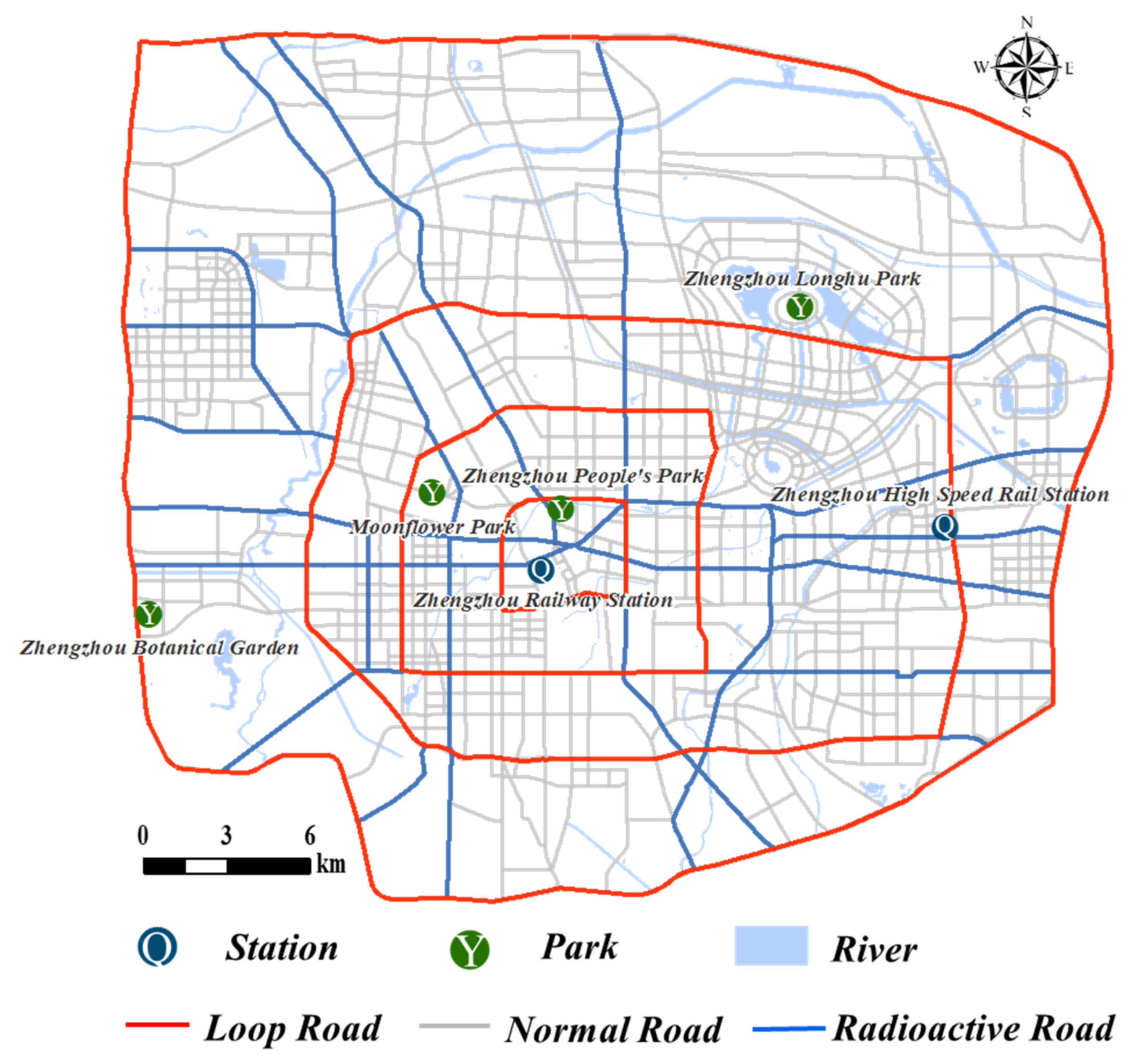
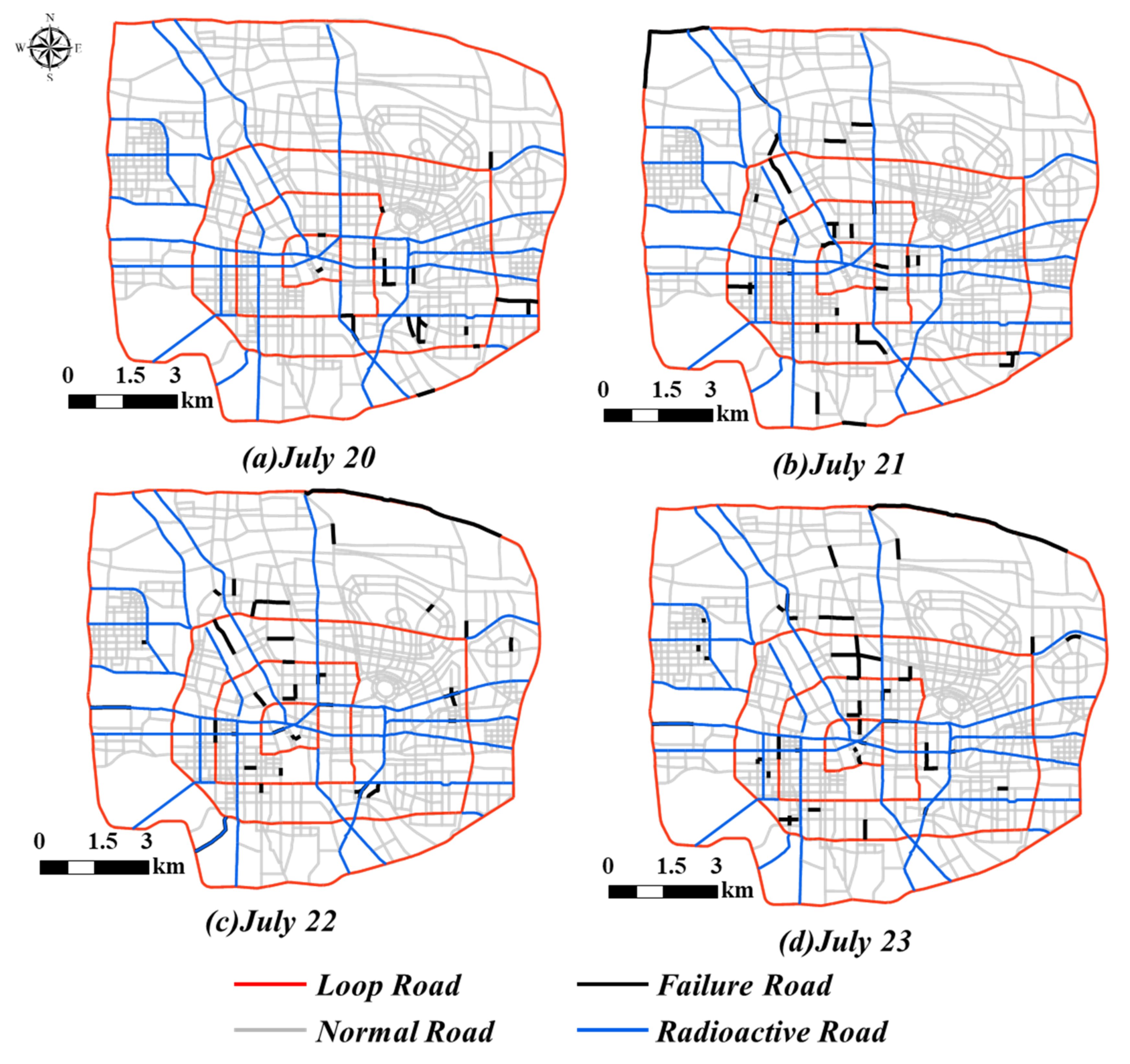
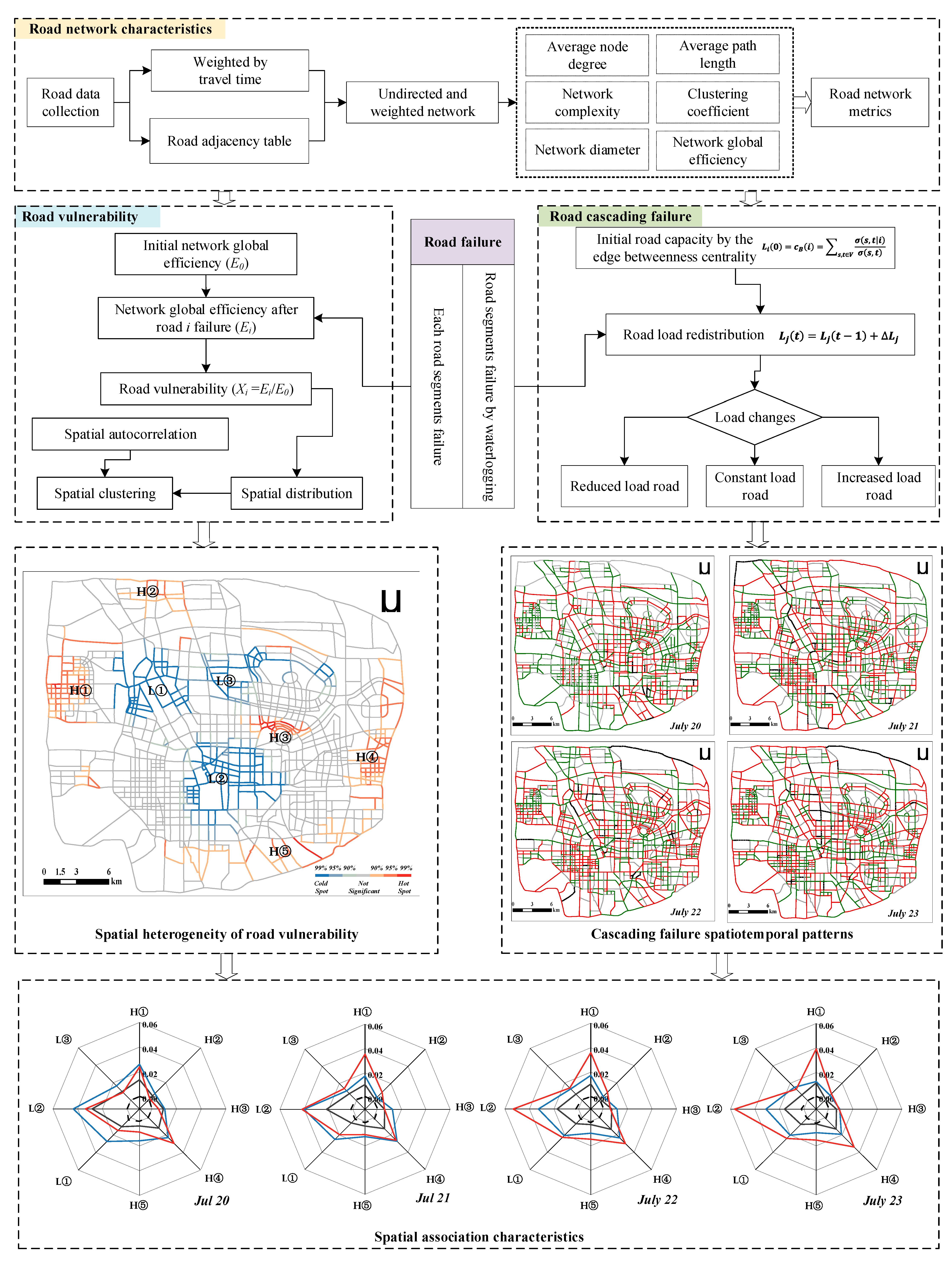
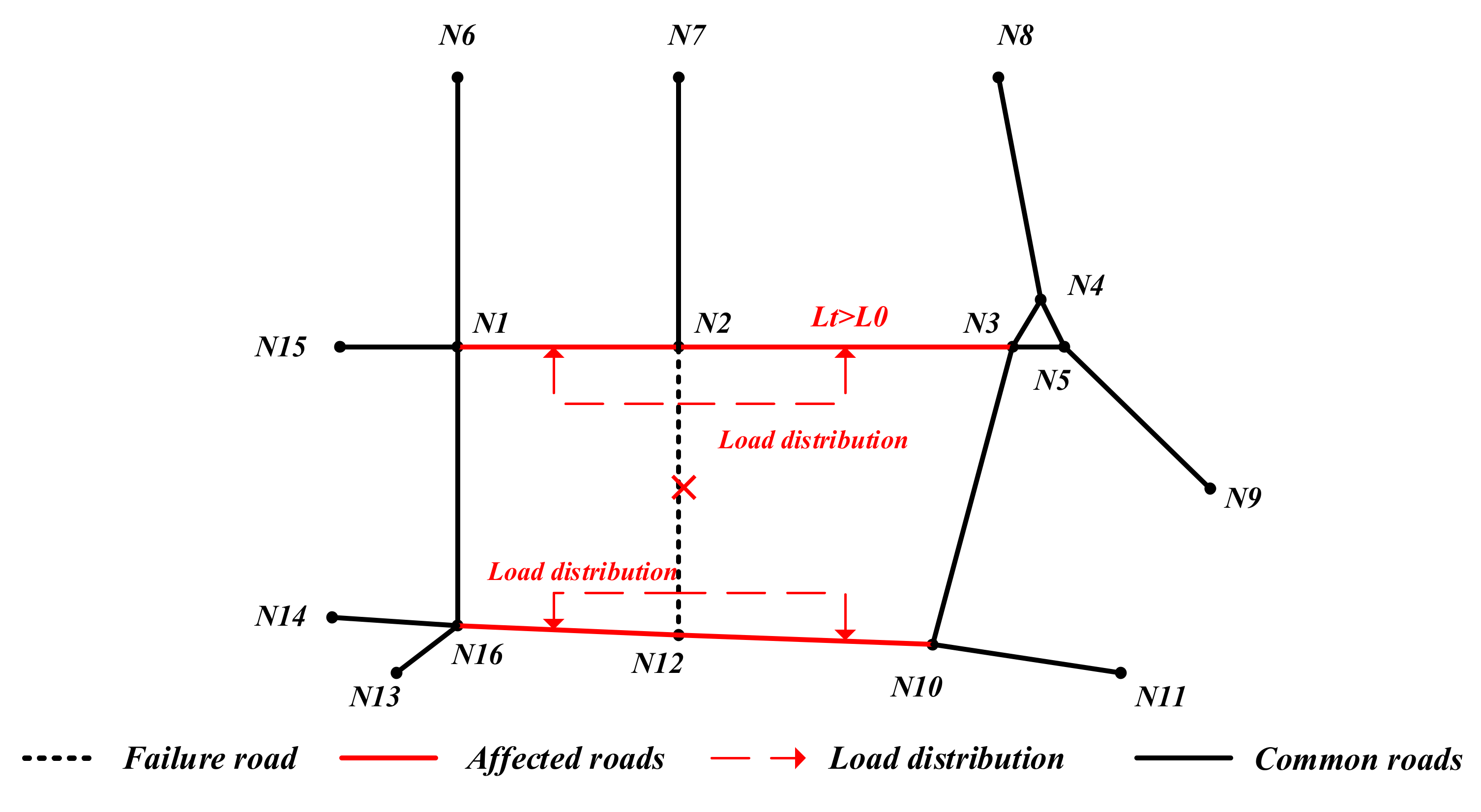
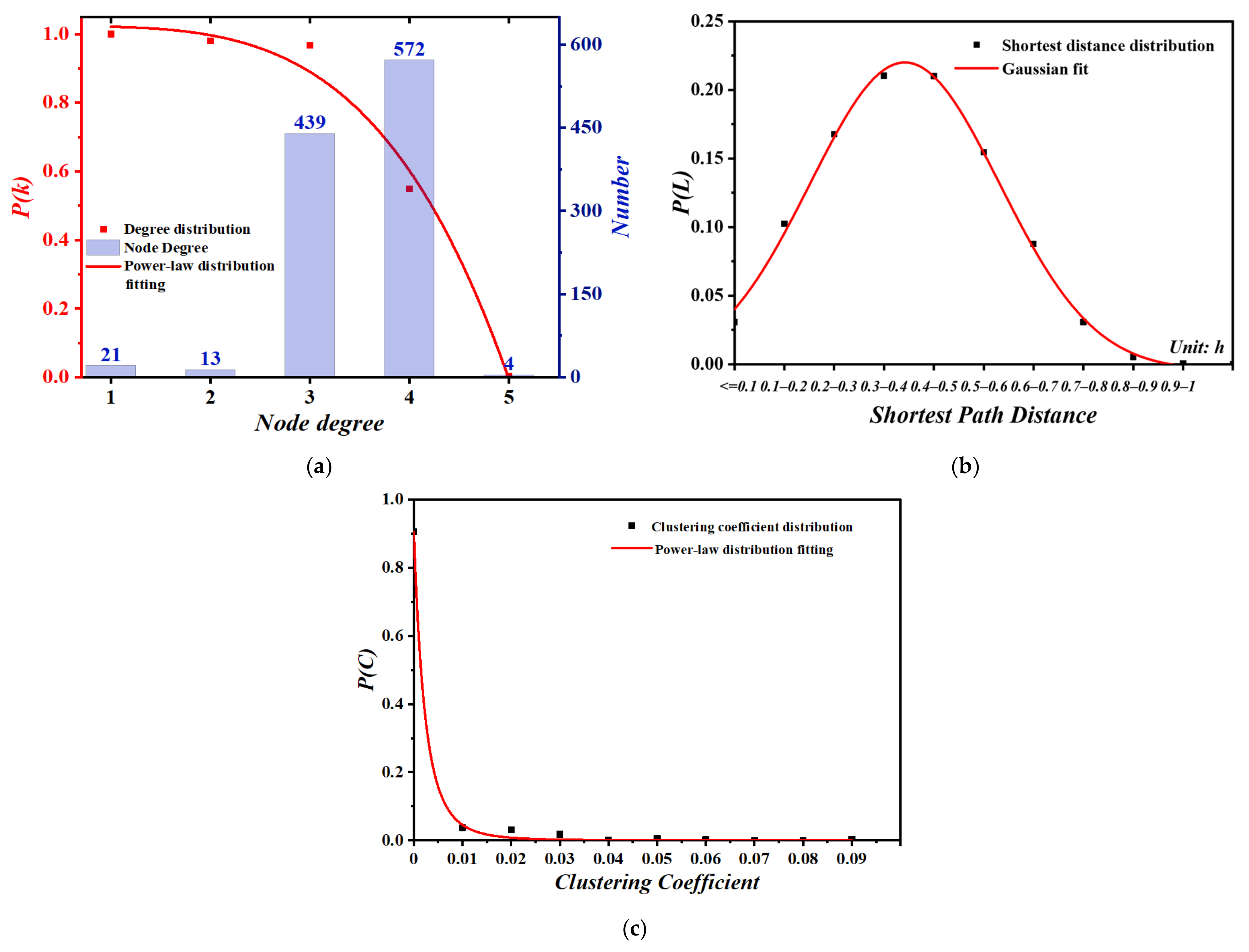
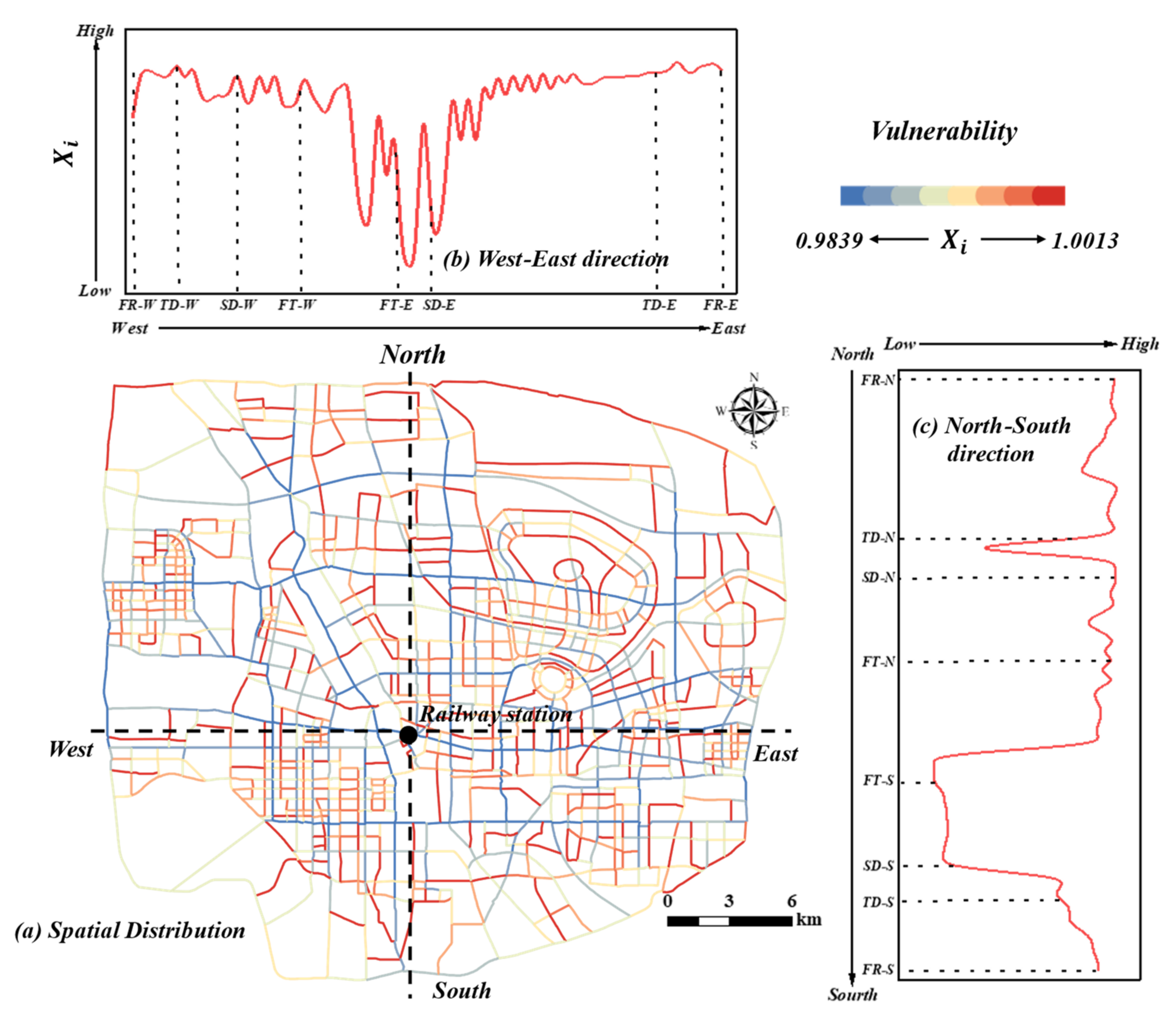
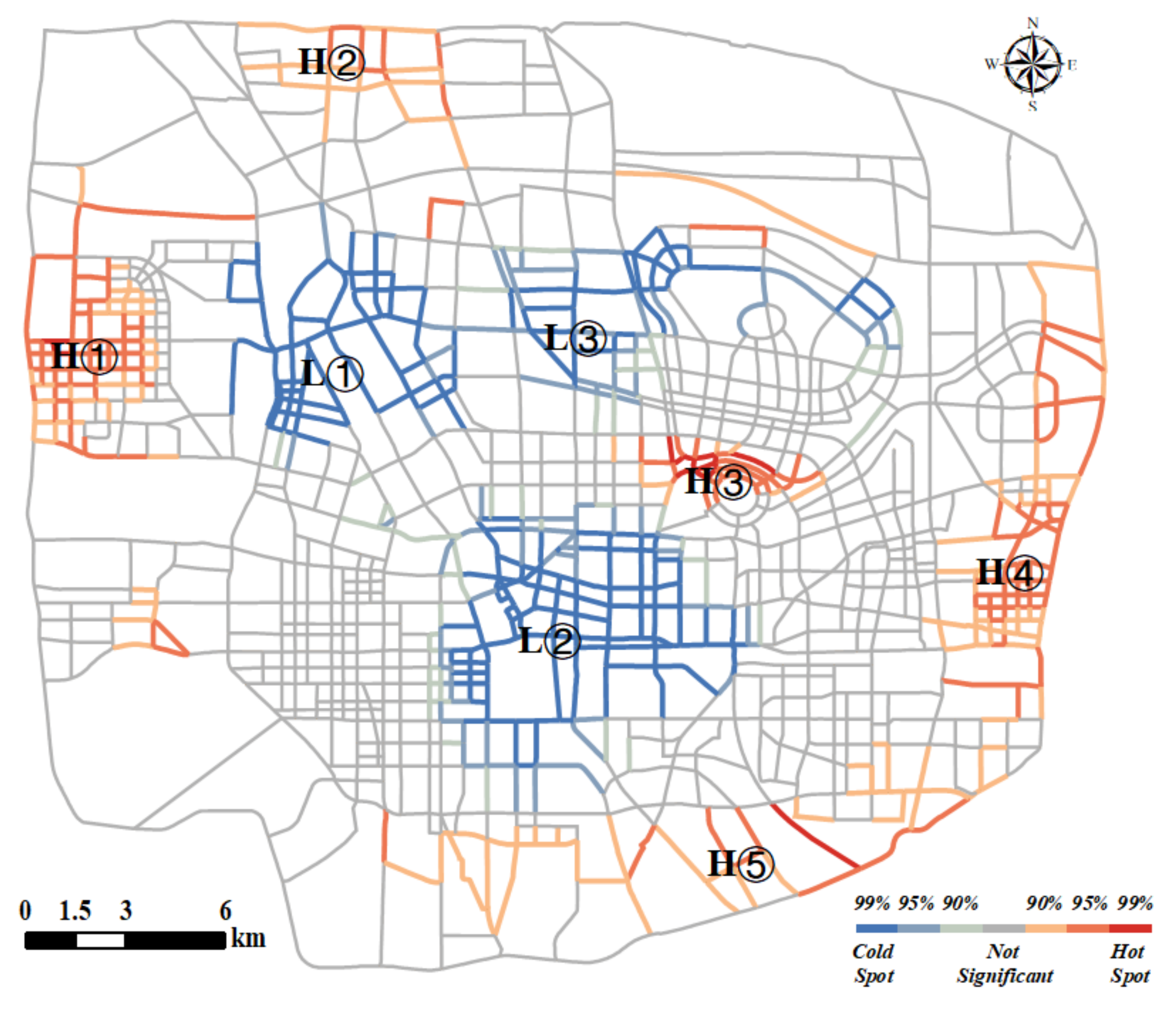
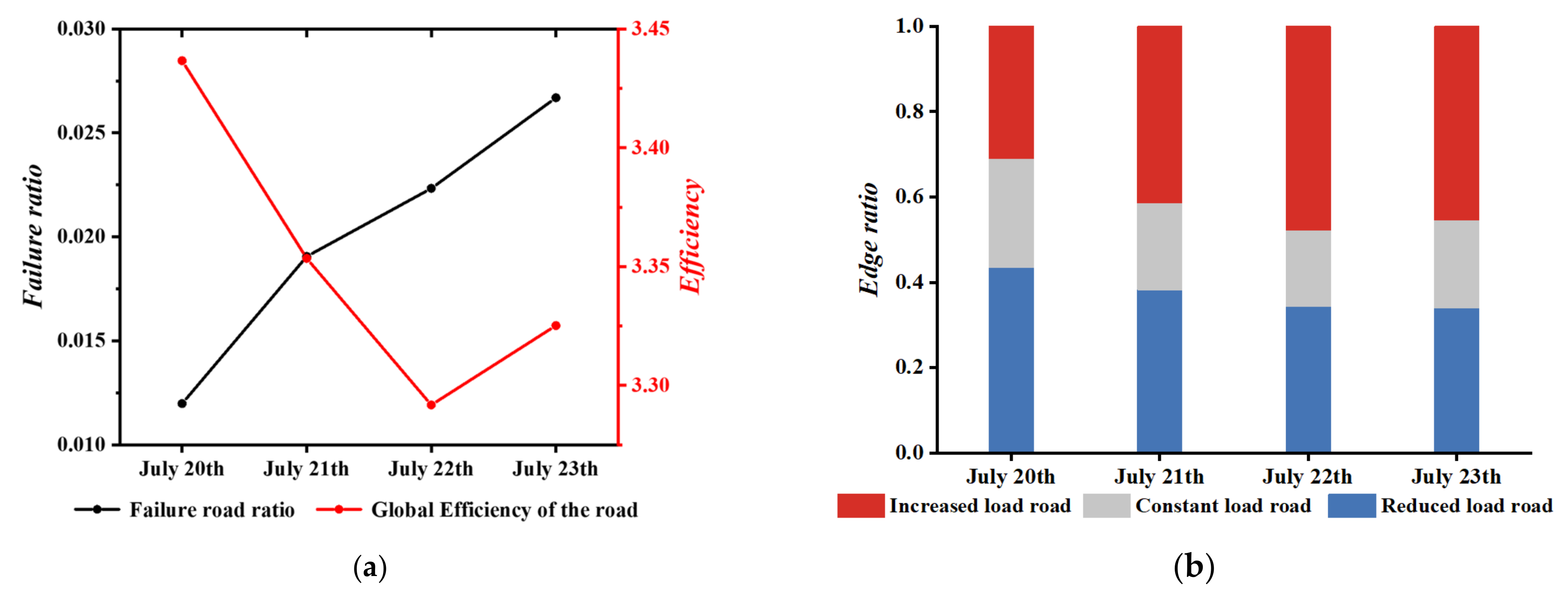
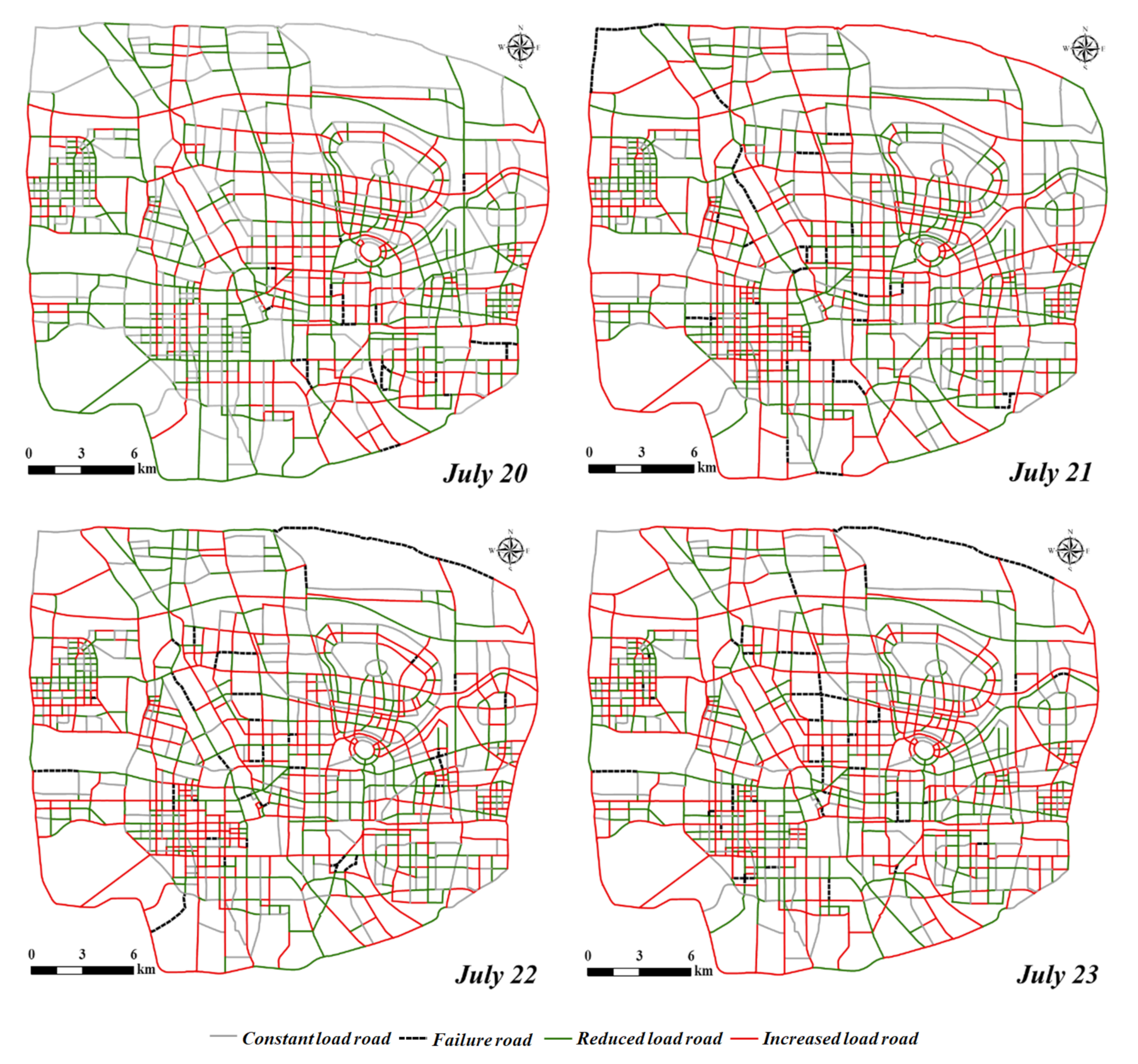
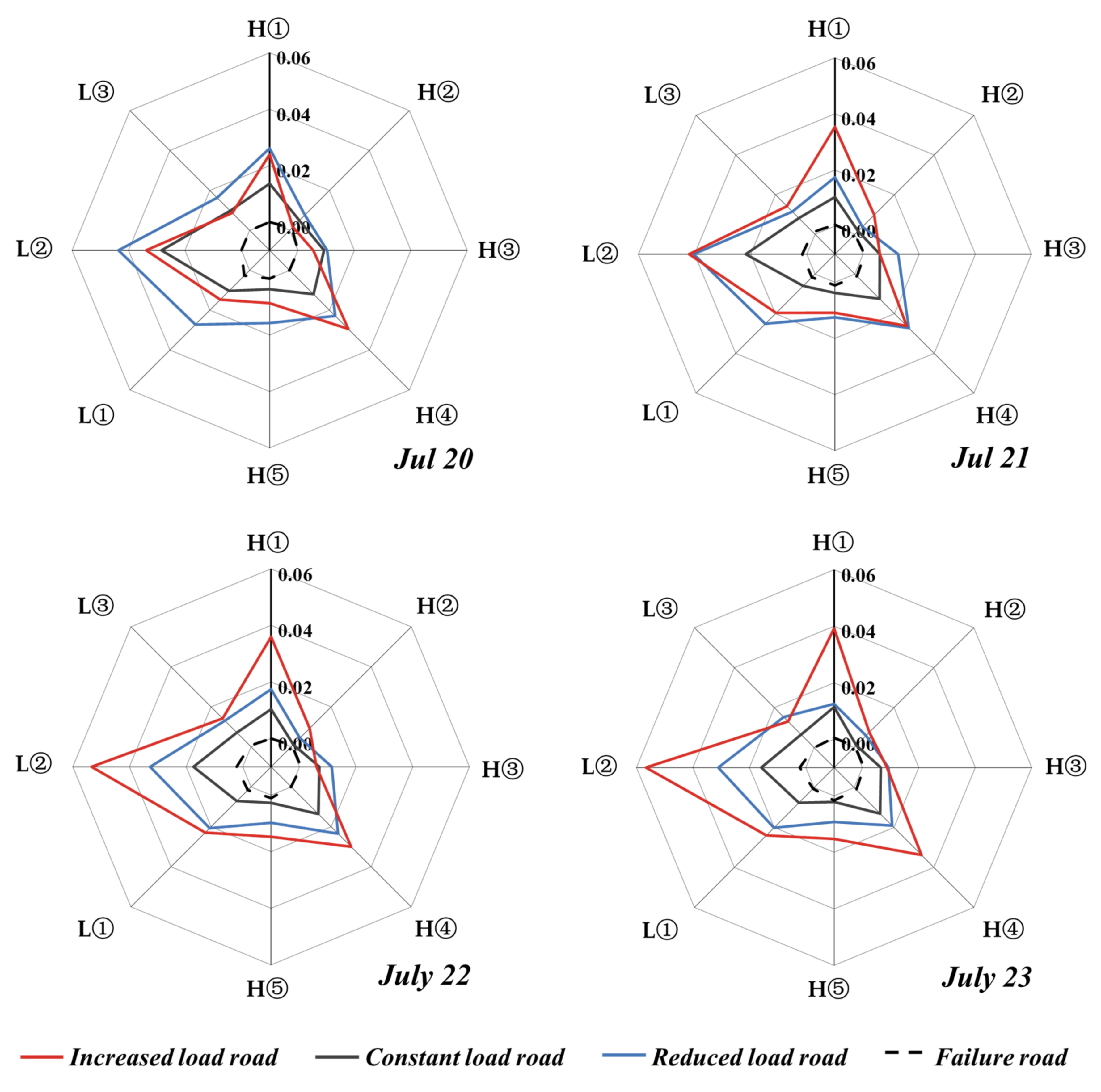
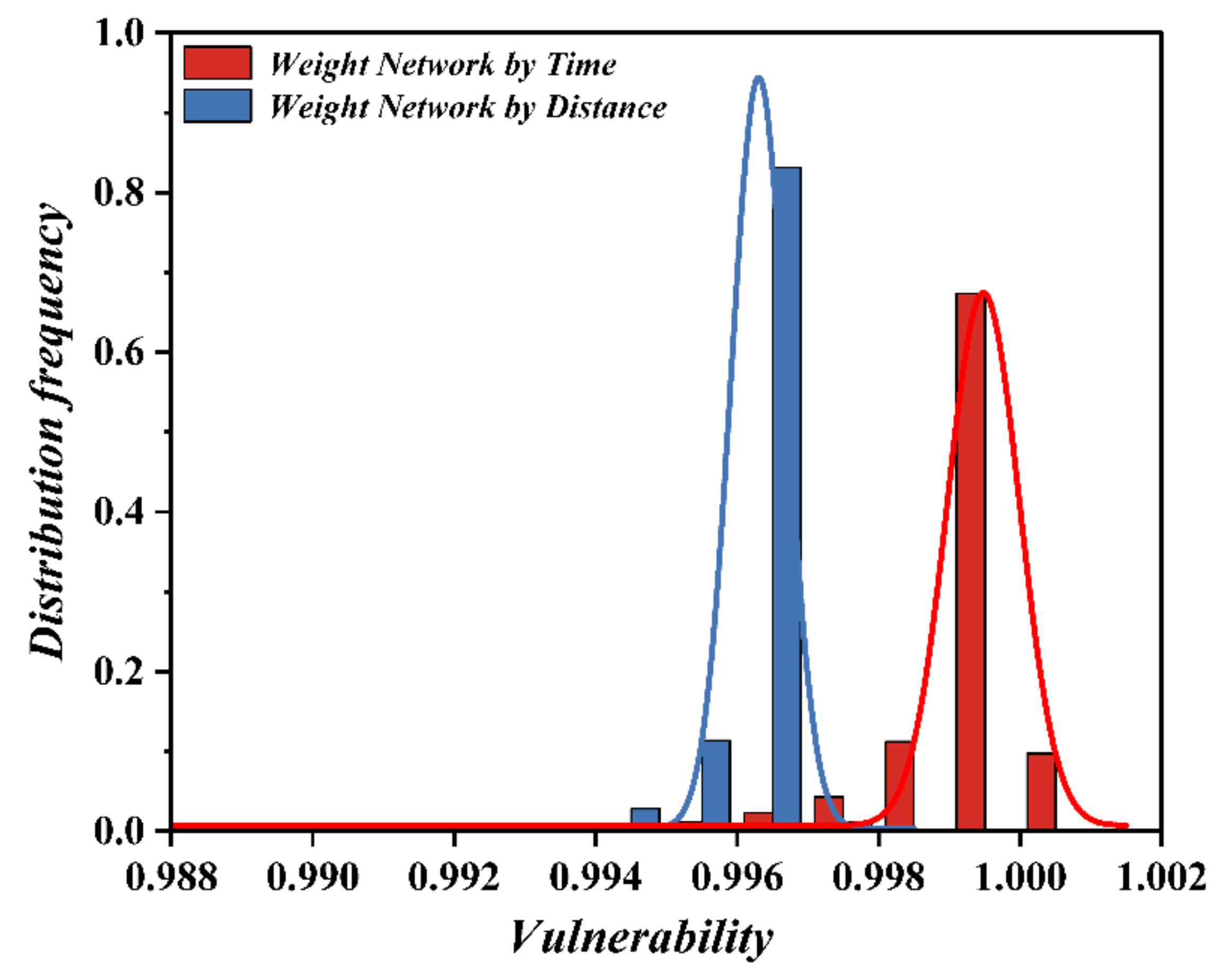
| Durations (min) | Max. (mm) | Time (from–to) | Durations (min) | Max. (mm) | Time (from–to) |
|---|---|---|---|---|---|
| 5 | 17.3 | 16:35–16:40 | 150 | 258.8 | 15:20–17:50 |
| 10 | 33.7 | 16:35–16:45 | 180 | 271.0 | 15:00–18:00 |
| 15 | 39.1 | 16:30–16:45 | 240 | 351.4 | 14:30–18:30 |
| 20 | 53.2 | 16:25–16:45 | 360 | 378.2 | 13:30–19:30 |
| 30 | 101.0 | 16:20–16:50 | 540 | 418.4 | 11:00–20:00 |
| 45 | 150.2 | 16:10–16:55 | 720 | 458.6 | 09:30–21:30 |
| 60 | 201.9 | 16:00–17:00 | 1440 | 552.5 | 20:00 (19 July)–20:00 (20 July) |
| 90 | 236.1 | 15:30–17:00 | 3 days | 624.1 | 00:00 (19 July)–00:00 (22 July) |
| 120 | 253.6 | 15:30–17:30 |
| Road Class | Expressway | Main Road | Secondary Arterial Road | Tertiary Arterial and Feeder Road |
|---|---|---|---|---|
| Speed * (km/h) | 40 | 30 | 25 | 10 |
| Number | 140 | 225 | 478 | 993 |
| Metrics | Formulas | Description |
|---|---|---|
| Average node degree | The average of the degrees of all nodes in the network | |
| Network complexity | The development level of the network | |
| Network diameter | The maximum value of the shortest distance of all node pairs in the network | |
| Average path length | The degree of connectivity between nodes as a whole | |
| Clustering coefficient | The aggregation of nodes in the network | |
| Global network efficiency | The connectivity efficiency of the network |
| Road Type | Number of Edges | Descriptive Statistics | |||||
|---|---|---|---|---|---|---|---|
| >1 | =1 | <1 | Max | Min | Mean | Standard Deviation | |
| Expressway vulnerability | 0 | 0 | 140 | 0.9998 | 0.9876 | 0.9967 | 0.0034 |
| Main Road vulnerability | 0 | 0 | 225 | 0.9999 | 0.9839 | 0.9970 | 0.0028 |
| Secondary Arterial Road vulnerability | 3 | 1 | 474 | 1.0004 | 0.9959 | 0.9992 | 0.0007 |
| Tertiary Arterial Road and Feeder Road vulnerability | 17 | 160 | 816 | 1.0013 | 0.9989 | 0.9999 | 0.0002 |
| All roads vulnerability | 20 | 161 | 1655 | 1.0013 | 0.9839 | 0.9991 | 0.0018 |
| Different Vulnerability Area | Road Length | Distance from the Urban Center | Travel Time |
|---|---|---|---|
| Concentration areas of vulnerability | 0.541 ** | 0.643 ** | 0.331 *** |
| nonsignificant areas of vulnerability | 0.057 * | 0.075 ** | 0.336 *** |
Publisher’s Note: MDPI stays neutral with regard to jurisdictional claims in published maps and institutional affiliations. |
© 2022 by the authors. Licensee MDPI, Basel, Switzerland. This article is an open access article distributed under the terms and conditions of the Creative Commons Attribution (CC BY) license (https://creativecommons.org/licenses/by/4.0/).
Share and Cite
Wu, Q.; Han, Z.; Cui, C.; Liu, F.; Zhao, Y.; Xie, Z. Vulnerability Identification and Cascading Failure Spatiotemporal Patterns on Road Network under the Rainstorm Disaster. ISPRS Int. J. Geo-Inf. 2022, 11, 564. https://doi.org/10.3390/ijgi11110564
Wu Q, Han Z, Cui C, Liu F, Zhao Y, Xie Z. Vulnerability Identification and Cascading Failure Spatiotemporal Patterns on Road Network under the Rainstorm Disaster. ISPRS International Journal of Geo-Information. 2022; 11(11):564. https://doi.org/10.3390/ijgi11110564
Chicago/Turabian StyleWu, Qirui, Zhigang Han, Caihui Cui, Feng Liu, Yifan Zhao, and Zhaoxin Xie. 2022. "Vulnerability Identification and Cascading Failure Spatiotemporal Patterns on Road Network under the Rainstorm Disaster" ISPRS International Journal of Geo-Information 11, no. 11: 564. https://doi.org/10.3390/ijgi11110564





